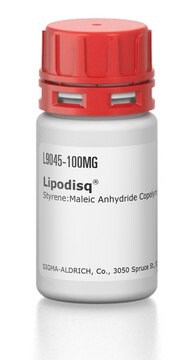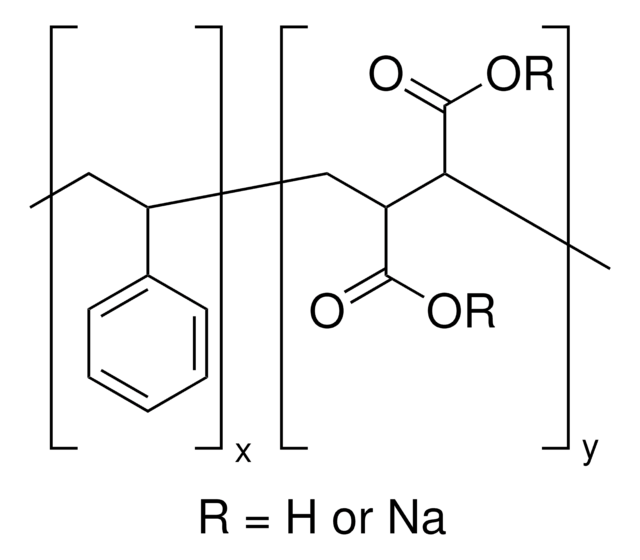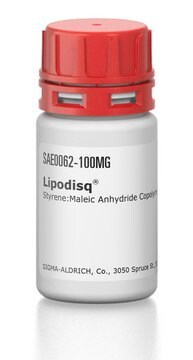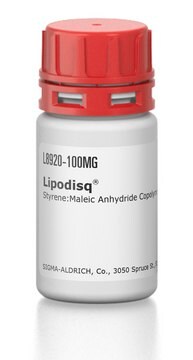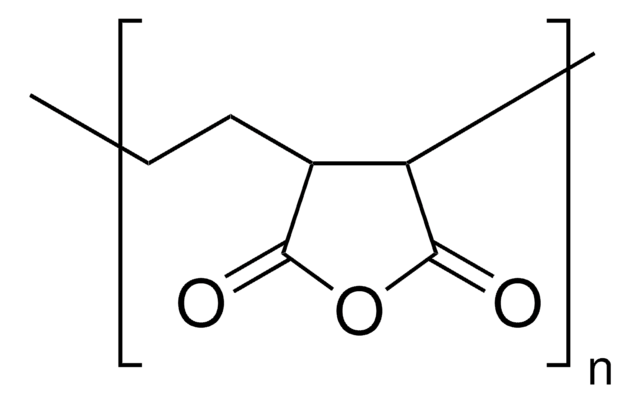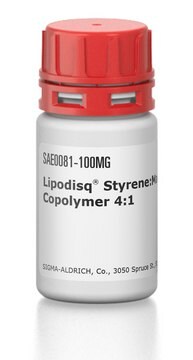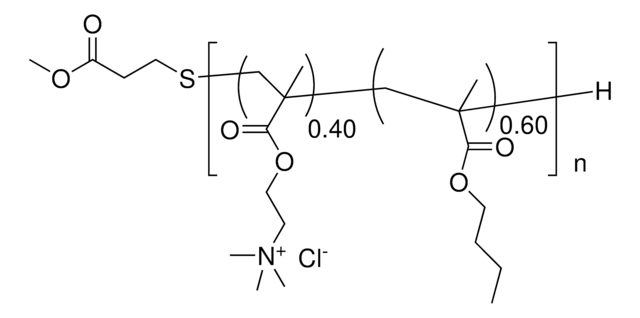L9170
Lipodisq®
Styrene: Maleic Anhydride Copolymer 3:1, Pre-hydrolyzed, powder, from synthetic
Synonym(s):
Lipid nanoparticle, Liposomal delivery system
Sign Into View Organizational & Contract Pricing
All Photos(2)
About This Item
UNSPSC Code:
12352202
NACRES:
NA.26
Recommended Products
biological source
synthetic
Quality Level
Assay
98-100%
form
powder
mol wt
9500 Da
storage condition
(Keep container tightly closed in a dry and well-ventilated place
Keep in a dry place)
storage temp.
room temp
Looking for similar products? Visit Product Comparison Guide
General description
Research area: Cell Structure
Lipodisq® polymers contain styrene and maleic acid monomer units. This product is the pre-hydrolyzed form of the SMA polymer, with styrene and maleic acid monomers. These polymer-lipid complexes are mainly generated by detergent-free methods.
Functional pH range: 6.0 - 9.0
Lipodisq® polymers contain styrene and maleic acid monomer units. This product is the pre-hydrolyzed form of the SMA polymer, with styrene and maleic acid monomers. These polymer-lipid complexes are mainly generated by detergent-free methods.
Functional pH range: 6.0 - 9.0
Application
Lipodisq® reagents are novel polymers derived from styrene and maleic acid. Lipodisq polymers are capable of forming nanosized lipid-based discoidal particles capable of incorporating membrane proteins. The Lipodisq technology can solubilize commonly used lipids such as dimyristoylphosphatidylcholine (DMPC) without the use of detergents. In general, Lipodisq polymers are potentially useful in mitigating the use of detergents for the solubilization of membrane proteins. Lipodisqs typically have a diameter of 9-10 nm at pH 7.4.
Legal Information
Lipodisq is a registered trademark of Malvern Cosmeceutics Limited
related product
Product No.
Description
Pricing
Storage Class Code
11 - Combustible Solids
WGK
WGK 3
Flash Point(F)
Not applicable
Flash Point(C)
Not applicable
Choose from one of the most recent versions:
Already Own This Product?
Find documentation for the products that you have recently purchased in the Document Library.
Customers Also Viewed
Indra D Sahu et al.
Biochemistry, 52(38), 6627-6632 (2013-08-30)
Pulsed EPR DEER structural studies of membrane proteins in a lipid bilayer have often been hindered by difficulties in extracting accurate distances when compared to those of globular proteins. In this study, we employed a combination of three recently developed
Detergent-Free Formation and Physicochemical Characterization of Nanosized Lipid-Polymer Complexes: Lipodisq
Orwick MC, et al.
Angewandte Chemie (International ed. in English), 51(19), 4653-4657 (2012)
Juan F Bada Juarez et al.
Chemistry and physics of lipids, 222, 51-58 (2019-05-19)
Lipodisq™ nanoparticles have been used to extract surface lipids from the cuticle of two strains (wild type, N2 and the bacteria-resistant strain, agmo-1) of the C. elegans nematode without loss of viability. The extracted lipids were characterized by thin layer
Juan Francisco Bada Juarez et al.
Biochimica et biophysica acta. Biomembranes, 1862(3), 183152-183152 (2019-12-18)
Dopamine receptors (DRs) are class A G-Protein Coupled Receptors (GPCRs) prevalent in the central nervous system (CNS). These receptors mediate physiological functions ranging from voluntary movement and reward recognition to hormonal regulation and hypertension. Drugs targeting dopaminergic neurotransmission have been
Maria Lyngaas Torgersen et al.
Journal of biomedical nanotechnology, 16(4), 419-431 (2020-09-25)
Many promising pharmaceutically active compounds have low solubility in aqueous environments and their encapsulation into efficient drug delivery vehicles is crucial to increase their bioavailability. Lipodisq nanoparticles are approximately 10 nm in diameter and consist of a circular phospholipid bilayer
Our team of scientists has experience in all areas of research including Life Science, Material Science, Chemical Synthesis, Chromatography, Analytical and many others.
Contact Technical Service